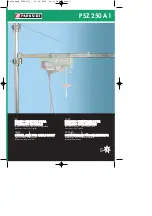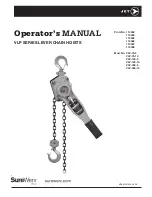
30
!
CAUTION
Improper operation of a hoist can create a potentially hazardous
situation which, if not avoided, could result in minor or moderate
injury, or property damage. To avoid such a potentially hazardous
situation
THE OPERATOR SHALL:
• Maintain a firm footing or be otherwise secured
when operating the hoist.
• Check brake function by tensioning the hoist prior
to each lift operation.
• Use hook latches. Latches are to retain slings,
chains, etc. under slack conditions only.
• Make sure the hook latches are closed and not
supporting any parts of the load.
• Make sure the load is free to move and will clear all
obstructions.
• Avoid swinging the load or hook.
• Make sure hook travel is in the same direction as
shown on controls.
• Inspect the hoist regularly, replace damaged or
worn parts, and keep appropriate records of
maintenance.
• Use the hoist manufacturer’s recommended parts
when repairing the unit.
• Lubricate load chain per hoist manufacturer’s
recommendations.
•
NOT
use the hoist load limiting or warning device to
measure load.
•
NOT
use limit switches as routine operating stops.
They are emergency devices only.
•
NOT
allow your attention to be diverted from
operating the hoist.
•
NOT
allow the hoist to be subjected to sharp
contact with other hoists, structures, or objects
through misuse.
•
NOT
adjust or repair the hoist unless qualified to
perform such adjustments or repairs.
Summary of Contents for SMR2Q Series
Page 44: ...This Page Intentionally Left Blank...
Page 46: ...46 9 1 Electric Parts Figure 9 1 1 Electric Parts...
Page 48: ...48 9 2 Pendant and Power Supply Parts Figure 9 2 1 Pendant and Power Supply Parts...
Page 50: ...50 9 3 Side Plates and Suspension Parts Figure 9 3 1 Side Plates and Suspension Parts...
Page 52: ...52 9 4 Motor Parts Figure 9 4 1 Motor Parts...
Page 54: ...This Page Intentionally Left Blank...
Page 55: ...This Page Intentionally Left Blank...
Page 56: ...www kito ca...

































